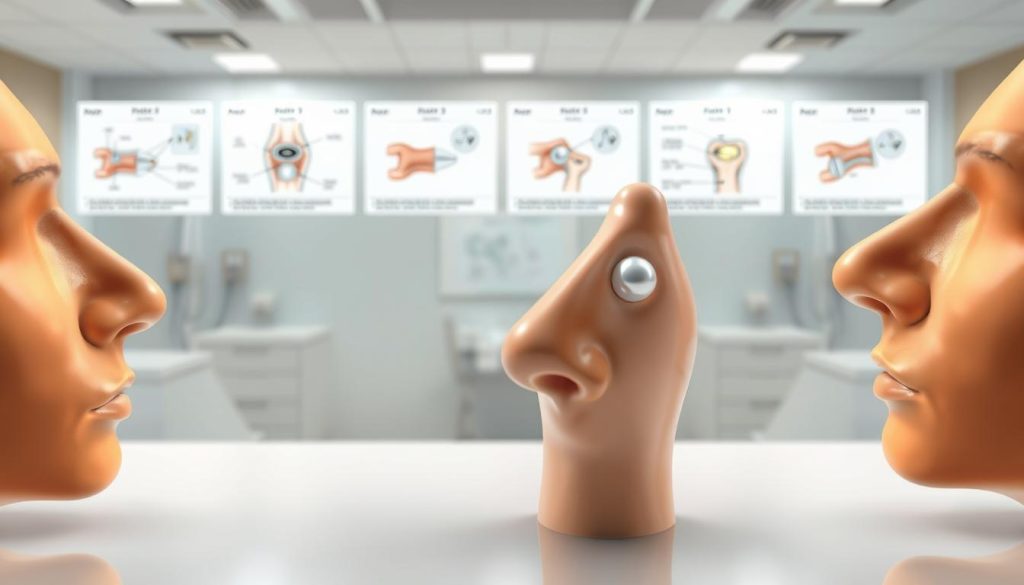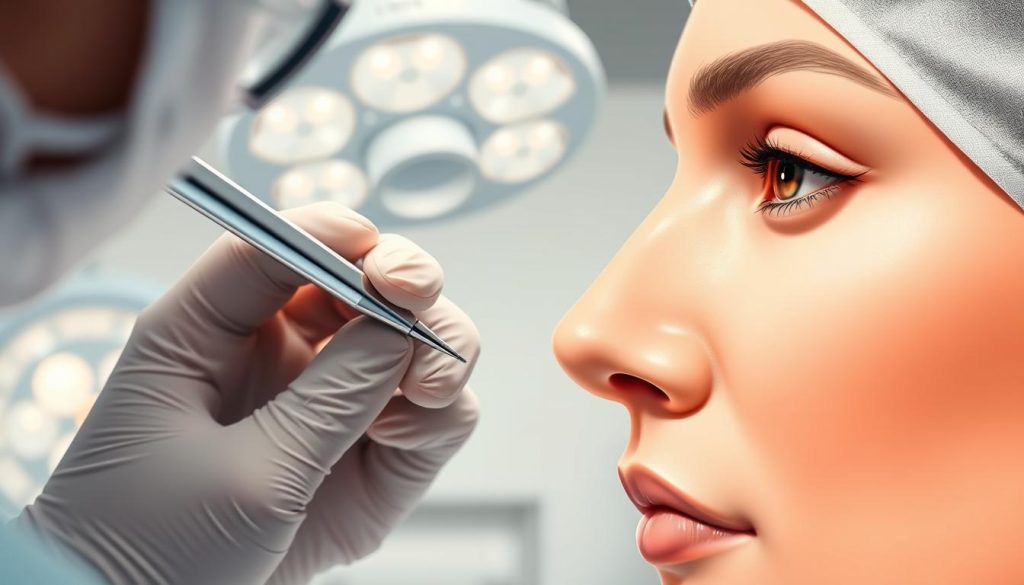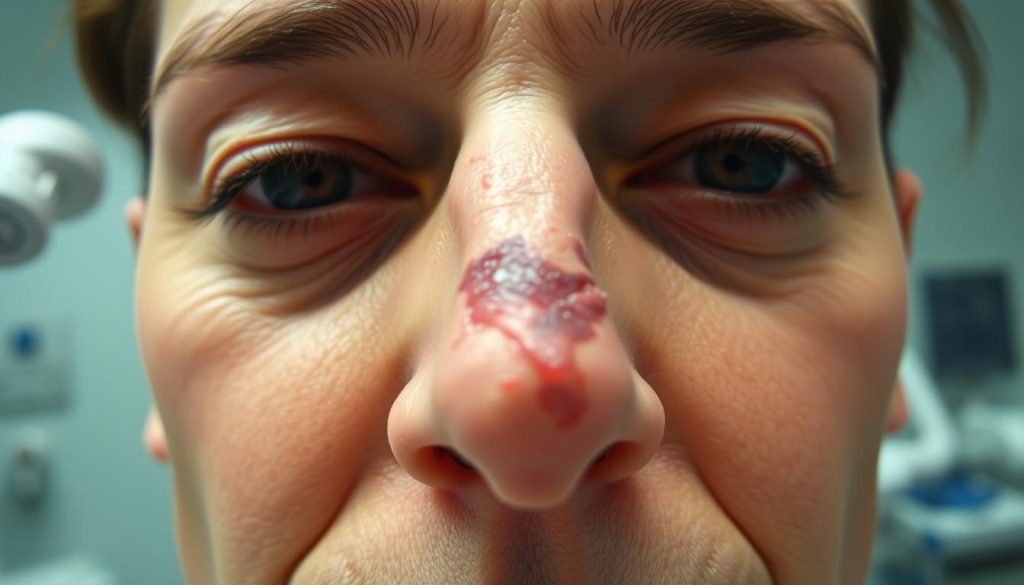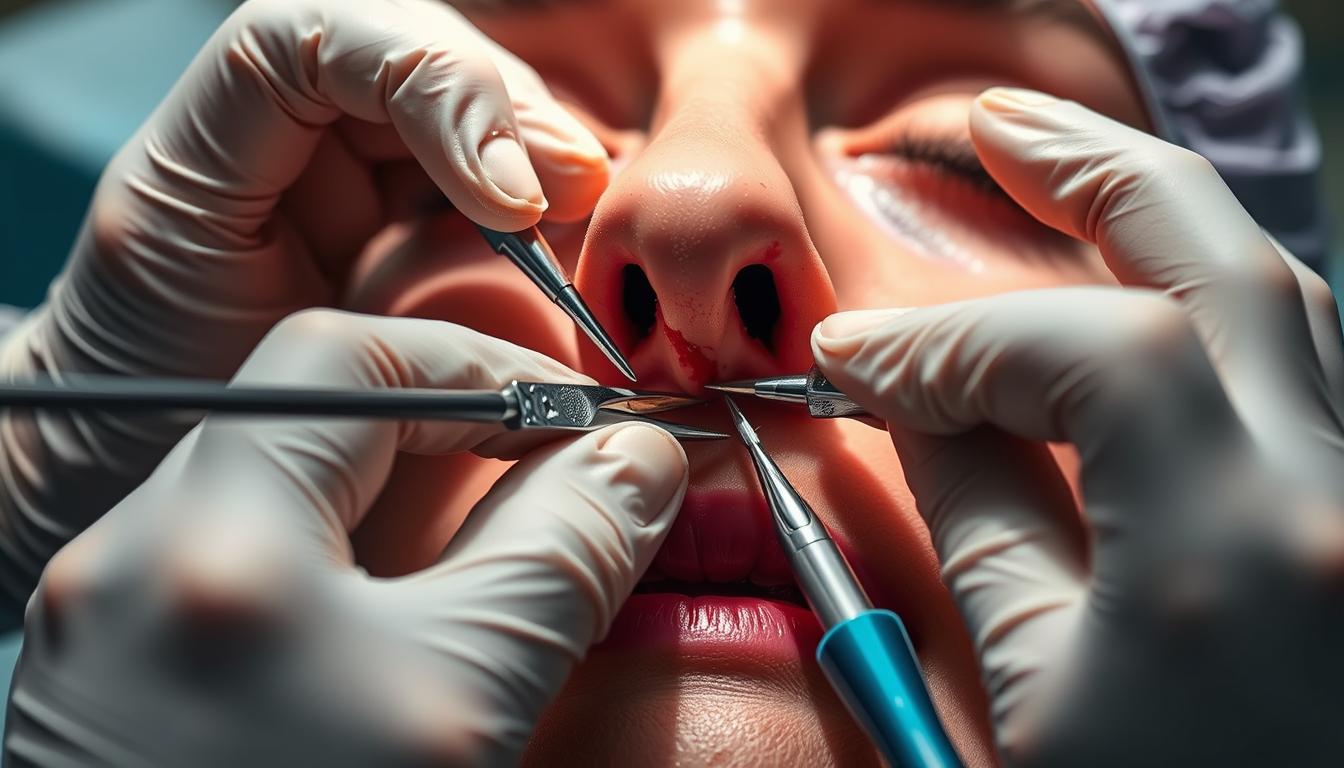Rhinoplasty, commonly referred to as a “nose job,” is a surgical procedure designed to reshape the nose for aesthetic or functional purposes. This comprehensive guide explores both the benefits and potential risks associated with nose augmentation procedures.
Modern rhinoplasty techniques have evolved to address not only cosmetic concerns but also functional issues like breathing difficulties and structural abnormalities. The surgery can significantly impact facial harmony and balance, as the nose is a central feature that influences overall appearance.
Both surgical and nonsurgical options are available, depending on the patient’s specific goals and desired results. Understanding the full spectrum of nose augmentation options helps patients set realistic expectations.
Key Takeaways
- Rhinoplasty can address both aesthetic and functional concerns.
- Surgical and nonsurgical options are available for nose augmentation.
- The procedure can significantly impact facial harmony and appearance.
- Modern rhinoplasty techniques address cosmetic and functional issues.
- Understanding the options helps patients set realistic expectations.
What is Nose Augmentation?
The concept of nose augmentation encompasses a range of procedures, from surgical rhinoplasty to non-surgical nose reshaping using dermal fillers. Nose augmentation is designed to enhance the shape and size of a person’s nose, bringing it into better proportion with the rest of the face.
Nose augmentation can be achieved through different methods, each with its own benefits and considerations.
Surgical vs. Non-Surgical Options
Surgical rhinoplasty involves altering the bone, cartilage, and soft tissue of the nose to achieve desired changes in shape, size, or function. In contrast, non-surgical nose augmentation, also known as liquid rhinoplasty, uses injectable fillers to temporarily modify the nose’s appearance without incisions or significant downtime.
Common Reasons People Choose Nose Augmentation
Individuals seek nose augmentation for various reasons, including correcting a crooked nose, smoothing a prominent bump, or addressing breathing difficulties caused by a deviated septum. The procedure can be purely cosmetic, purely functional, or a combination of both purposes, depending on the patient’s goals and anatomy.
Types of Nose Augmentation Procedures
Nose augmentation can be achieved through various surgical and non-surgical methods, catering to different patient needs and preferences. The choice of procedure depends on the individual’s nasal structure, the desired outcome, and the surgeon’s recommendation.
Open Rhinoplasty
Open rhinoplasty involves making a small incision across the columella, allowing the surgeon complete access to nasal structures for more extensive reshaping. This approach provides maximum visibility of the internal nasal anatomy, making it ideal for complex cases requiring significant structural changes or precision work on the nasal tip.
Closed Rhinoplasty
Closed rhinoplasty utilizes incisions entirely within the nostrils, leaving no visible external scarring. It is typically used for less complex nasal modifications. While it offers the advantage of no visible scarring, it provides more limited access to nasal structures and may not be suitable for extensive reshaping.
Liquid Rhinoplasty
Liquid rhinoplasty, or nonsurgical rhinoplasty, uses injectable dermal fillers to temporarily alter the nose’s appearance without surgery or significant downtime. This non-surgical option can camouflage bumps, improve symmetry, lift a drooping tip, or add definition. Fillers typically last 6-12 months, making this an excellent option for patients who want to “test drive” changes before committing to permanent surgical modification.
| Procedure | Description | Recovery Time |
|---|---|---|
| Open Rhinoplasty | Surgical procedure with an external incision | 1-2 weeks |
| Closed Rhinoplasty | Surgical procedure with internal incisions | 1-2 weeks |
| Liquid Rhinoplasty | Non-surgical procedure using dermal fillers | Minimal downtime |

Key Benefits of Nose Augmentation

Nose augmentation, also known as rhinoplasty, offers numerous benefits that can significantly impact an individual’s quality of life. This procedure can address both aesthetic and functional concerns, leading to overall patient satisfaction.
Aesthetic Improvements
Aesthetic improvements from nose augmentation include enhanced facial harmony and better proportion between facial features. Rhinoplasty can correct specific nasal characteristics that patients find undesirable, such as a prominent dorsal hump, bulbous tip, or crooked nose.
Functional Benefits
Functional benefits extend beyond appearance, with many patients experiencing significantly improved breathing after correction of a deviated septum or other structural abnormalities. Improved nasal function can lead to better sleep quality and reduced sinus infections.
Psychological and Confidence Benefits
The psychological benefits of nose augmentation can be profound, with many patients reporting increased self-confidence and reduced social anxiety. For patients who have experienced bullying due to their nasal appearance, rhinoplasty can provide emotional relief and a sense of control over their self-image.
Overall, the combination of aesthetic, functional, and psychological improvements makes nose augmentation one of the most satisfying plastic surgery procedures for many patients.
Potential Risks and Complications
Understanding the potential risks and complications associated with rhinoplasty is crucial for informed decision-making. While rhinoplasty can significantly enhance one’s appearance and confidence, it’s essential to consider the potential risks involved.
Short-Term Side Effects
Short-term side effects of rhinoplasty typically include swelling and bruising around the eyes and nose, temporary numbness, nasal congestion, and mild to moderate discomfort in the days following surgery.
- Most patients experience noticeable swelling for 2-4 weeks.
- Residual swelling can subtly affect the final appearance potentially lasting up to a year.
Long-Term Complications
Potential long-term complications, though rare when performed by a qualified surgeon, may include unsatisfactory aesthetic results, breathing difficulties, nasal asymmetry, or perforation of the nasal septum.
| Complication | Description |
|---|---|
| Unsatisfactory Aesthetic Results | Results not meeting patient expectations. |
| Breathing Difficulties | Complications affecting nasal function. |
| Nasal Asymmetry | Uneven healing causing asymmetry. |
When to Seek Medical Attention
Serious complications requiring immediate medical attention include excessive bleeding, signs of infection (increasing pain, fever, unusual discharge), severe swelling, or difficulty breathing.
Patients should thoroughly discuss their medical history with their surgeon to minimize risks.

Preparing for Nose Augmentation

The journey to a perfectly augmented nose begins with thorough preparation and consultation with a qualified surgeon. Proper preparation is key to a successful rhinoplasty procedure.
Initial Consultation Process
The initial consultation is a comprehensive evaluation where the surgeon assesses the patient’s nasal structure, facial proportions, skin thickness, and overall health to determine their candidacy for the procedure. Patients should openly discuss their goals, concerns, and medical history.
Medical Evaluations and Requirements
Medical evaluations may include blood tests, physical examination, and assessment of nasal function through breathing tests. These tests ensure that the patient is healthy enough for surgery. Patients are typically required to avoid certain medications and supplements that can increase bleeding risk.
Pre-Procedure Guidelines
Pre-procedure guidelines often include arranging for someone to drive the patient home after surgery, preparing a recovery area at home, and obtaining prescribed medications in advance. For non-surgical rhinoplasty, preparation is less intensive but still requires avoiding blood-thinning medications before the procedure.
The Nose Augmentation Procedure
Nose augmentation, commonly known as rhinoplasty, is a surgical procedure that can enhance the appearance and function of the nose. This procedure is typically performed on an outpatient basis, allowing patients to return home the same day.
What Happens During Surgery
During rhinoplasty surgery, the surgeon makes incisions either inside the nostrils or across the base of the nose, depending on the technique used. The surgeon then raises the skin covering the nasal bone and cartilage, allowing for modifications to be made.
- The surgeon may reduce, add to, or rearrange the underlying bone and cartilage to achieve the desired shape or correct a deviated septum.
- In some cases, additional cartilage grafts may be required to provide structural support or improve contours.
Anesthesia Options
Patients undergoing rhinoplasty may receive either general anesthesia or local anesthesia with sedation, depending on the complexity of the procedure and personal preferences.
Duration and Immediate Post-Procedure Care
The rhinoplasty procedure typically takes between one to three hours to complete. After the surgery, patients require immediate care, including monitoring for bleeding, managing pain, and keeping the head elevated to reduce swelling.
Recovery and Results: What to Expect
As patients recover from rhinoplasty, they can anticipate a series of physical changes that ultimately lead to the desired results. Initially, patients may experience mild to moderate discomfort, which can be managed with medication. A nasal splint is typically worn for about a week to protect the nasal bones and cartilage.
During the first few weeks, patients may notice significant swelling and bruising around the eyes and nose. However, most patients can return to work or school after 1 to 2 weeks, depending on their activity level. It’s essential to follow specific care instructions, including elevating the head while sleeping and avoiding strenuous activities for 3 to 4 weeks.
Full results from rhinoplasty surgery emerge gradually, with noticeable improvements visible after 12 to 18 months. By choosing a qualified surgeon and following post-operative instructions, patients can achieve successful long-term results.
FAQ
What is the difference between surgical and non-surgical rhinoplasty?
Surgical rhinoplasty involves making incisions to alter the structure and shape of the nasal septum, whereas non-surgical rhinoplasty uses fillers to make temporary changes to the appearance of the nasal area.
How long does it take to recover from rhinoplasty surgery?
The recovery time can vary, but most people can expect swelling and bruising to last several weeks, with full results taking several months to become apparent.
Will rhinoplasty surgery improve my breathing?
If the procedure is done to correct a deviated nasal septum, it can improve breathing by allowing for better airflow through the nasal passages.
What are the potential complications of rhinoplasty surgery?
As with any surgery, there are risks of complications, including infection, reaction to anesthesia, and unsatisfactory results, which may require additional procedures.
Can I undergo rhinoplasty if I have skin problems?
Certain skin conditions may need to be treated before undergoing rhinoplasty; a surgeon will assess the condition and advise on the best course of action.
How long does a liquid rhinoplasty procedure take?
A liquid rhinoplasty procedure typically takes about 15-30 minutes, and is often performed in a surgeon’s office or clinic.
Is rhinoplasty surgery painful?
Most people experience some discomfort after the procedure, but this is usually managed with pain medication, and the surgeon will provide guidance on post-operative care.
Will I need to wear a splint after rhinoplasty surgery?
A splint is often used to support the new shape of the nasal area during the initial healing process, usually for about a week.
